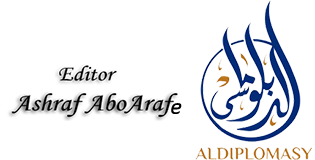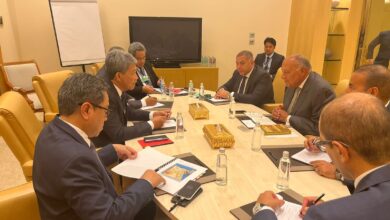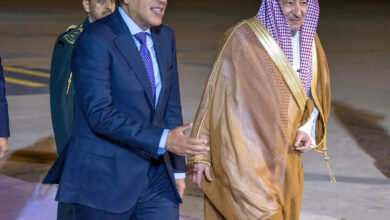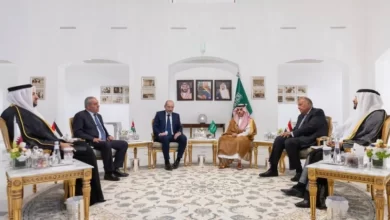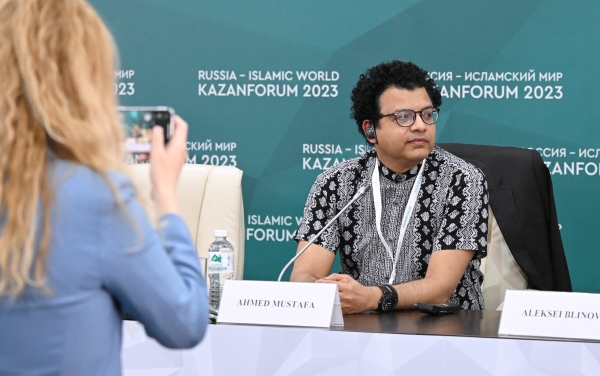
Commented by Ahmed Mostafa
The world we live in is characterized by intense globalization where economic cooperation between countries is taking center stage. One of such economic cooperation blocs is the Eurasia Economic Union, which comprises countries from the former Soviet Union. The population of the Eurasian Economic Union (EEU) is comprised of a diverse group of nations. According to the latest World Bank figures, the five EEU countries account for a total of (183 million) people as of 2019. These countries are the Russian Federation, Kazakhstan, Kyrgyzstan, Belarus, and Armenia.
On the other hand, there is the D8 Group, which is composed of eight Muslim-majority countries that are focused on strengthening economic ties among themselves. As of 2020, the population of the eight countries that make up the D-8 Organization for Economic Cooperation, commonly referred to as the Developing Eight (D-8), is estimated to be around (811 million) people. This figure is expected to continue to increase as the countries of Bangladesh, Egypt, Indonesia, Iran, Malaysia, Nigeria, Pakistan, and Turkey continue to experience population growth.
The D-8 countries have seen a steady increase in population over the past few decades, with the current population being made up of more than 20 ethnicities, languages, and religious backgrounds. In turn, this makes the countries of the D-8 incredibly diverse and provides a unique opportunity to understand the different factors that have contributed to the rapid growth experienced in this region.
This essay will explore the most possible ways for economic cooperation between the Eurasia Economic Zone and a group of D8, those two blocks of around 1 Billion of population.
How to enhance economic cooperation between EEU & D8?
Greater economic cooperation between the EEU and the D8 can benefit both parties economically, as well as enhance the countries’ abilities to participate in the global trade market. The EEU is positioned to support the D8 countries by increasing their integration levels and providing more markets for the countries to benefit from. To foster greater economic cooperation, there are a few key steps to take.
Firstly, the EEU should seek direct investment opportunities in D8 countries in order to provide D8 countries with more capital to fuel economic growth and enterprise. Furthermore, the EEU must attend to the export needs of the D8 countries, encouraging them to expand their export capabilities by allowing them access to EEU markets.
Additionally, strong trade bonds should be developed between the EEU and D8 countries by removing any detrimental tax, customs, or trade barriers that exist between them. Improving the existing political framework between the two regions will provide a smoother economic transition. To further stimulate economic cooperation, the EEU should engage the private sector in innovative projects, such as joint research, creative capital investment, and joint technological development. Ultimately, by creating greater economic cooperation between the two regions, the governments of both countries will be able to provide greater economic stability and growth opportunities to their citizens.
One of the possible ways of cooperation is (trade): The two economic blocs can establish a trade agreement that will allow them to increase trade by reducing tariffs and other trade barriers. According to the World Bank, trade between the D8 countries increased from $200 billion in 2000 to $1 trillion in 2018. The Eurasia Economic Zone can leverage this economic cooperation to increase its exports to the D8 countries, which will, in turn, increase its economic growth.
Four main fields should be focused on between the two trading blocks:-
Another possible way is (investment): The D8 countries are rich in natural resources, while the Eurasia Economic Zone has the necessary expertise and technology to exploit these resources. Therefore, the two economic blocs can cooperate to invest in sectors such as agriculture, mining, and energy. This partnership will allow the D8 countries to harness their natural resources while creating employment opportunities for the people in the Eurasia Economic Zone.
Moreover, both economic blocs can cooperate in (tourism): The D8 countries have some of the world’s most beautiful natural sceneries, which can be exploited to attract tourists from the Eurasia Economic Zone. On the other hand, the Eurasia Economic Zone has a rich cultural heritage, which can be a source of attraction to the D8 countries’ tourism industry. Cooperation in the tourism industry will increase the revenue for both economic blocs while promoting cultural exchange and understanding.
Lastly, (knowledge & education): The D8 countries can leverage the expertise and technology from the Eurasia Economic Zone to improve their education systems. On the other hand, the Eurasia Economic Zone can benefit from the D8 countries’ knowledge of Islamic civilization, which can be used to enrich their history and social sciences curricula.
(Plus media projects which represent the soft-power and will facilitate communications amid the peoples and regimes as well)
Possible Digital Cooperation between Eurasia Economic Zone and Group of D8:-
AI and Startups’ Possible Cooperation
Digital cooperation between Eurasia Economic Zone and the D8 group in AI and startups has great potential to create new businesses, enhance economic development and improve the quality of life for citizens of both regions.
The potential for cooperation between the Eurasia Economic Zone and the D8 group in AI and startups is significant. Here are some areas where collaboration can take place:
1. Talent Exchange: Both regions have a pool of talented and skilled individuals who can contribute to the development of AI and startup ecosystems. The exchange of talent between the two regions can help to transfer knowledge, skills, and experience, and create new opportunities for entrepreneurs and innovators.
2. Incubation and Acceleration: The establishment of joint incubation and acceleration programs can help to nurture startups and provide them with the necessary resources, mentorship, and funding to succeed. Such programs can also attract international investors and create new networks that can benefit entrepreneurs from both regions.
3. Research and Development: Cooperation in research and development can help to create new AI technologies and applications that can solve common problems and create new markets. Joint research projects can also help to share costs and risks and create new opportunities for collaboration between academia and industry.
4. Intellectual Property: The protection of intellectual property rights is critical for the success of startups and innovation. Cooperation in intellectual property rights can help to establish common standards and frameworks that can protect startups and encourage innovation.
Benefits of Cooperation in AI and Startups
Cooperation in AI and startups between the Eurasia Economic Zone and the D8 group can benefit both regions in several ways:
1. New Businesses: Cooperation in AI and startups can create new businesses that can provide jobs and generate economic growth. Such businesses can also create new opportunities for trade and investment between the two regions.
2. Enhanced Economic Development: Cooperation in AI and startups can enhance the economic development of both regions by creating new markets, improving efficiency and productivity, and promoting innovation.
3. Improved Quality of Life: Cooperation in AI and startups can improve the quality of life for citizens of both regions by providing access to new technologies and services that can improve healthcare, education, transportation, and other areas.
Android Phones: A Tool to Circumvent Economic Sanctions
In recent years, economic sanctions have become a common tool used by the international community to punish countries for their actions. The impact of these sanctions can be devastating, particularly for emerging economies. However, there is a solution that can help countries circumvent these sanctions: android phones.
Both the Eurasia economic zone and the D8 group have been subject to economic sanctions in the past, and they are still at risk of facing such sanctions in the future.
One way Android phones can help these countries is by enabling them to use alternative payment systems. For example, the use of cryptocurrencies such as Bitcoin, Ripple, Digital currency, or payment applications, can help countries avoid the restrictions of traditional banking systems, which are often targeted by economic sanctions. Additionally, the decentralized nature of these payment systems makes them less vulnerable to control by external powers.
Another way Android phones can help is by enabling countries to access the global market more easily. Many businesses and individuals around the world use Android phones to conduct business, communicate, and transfer funds. By using Android phones, countries in the Eurasia economic zone and the D8 group can connect with the global market and continue to trade with other nations, despite the imposition of sanctions.
Android phones can also help these countries to overcome the challenges of restricted access to technology. Economic sanctions often limit access to technology, making it difficult for countries to develop new industries and compete on a global scale. By using Android phones, countries can access new technologies, connect with developers and innovators around the world, and develop their own technology-based industries.
Android is one of the most popular operating systems for mobile phones globally, and its reach continues to expand. Eurasia Economic Zone and the D8 group are two regions that have experienced a significant increase in the number of Android users. This essay aims to provide statistics about the use of Android in these regions and explore how Android can be used to improve people’s lives.
The Number of Android Phones in Eurasia Economic Zone
According to a recent report by StatCounter Global Stats, Android is the most popular operating system for mobile phones in the Eurasia Economic Zone. In 2020, Android had a market share of 72.58%, while iOS had a market share of 24.22%. Other operating systems, such as KaiOS, Windows, and Samsung, had minimal market shares. The report also showed that the most popular Android version in the Eurasia Economic Zone was Android 10, with a market share of 34.47%. Android 6.0 Marshmallow, Android 7.0 Nougat, and Android 9.0 Pie followed closely with market shares of 20.56%, 15.09%, and 11.02%, respectively.
The Number of Android Phones in D8 Group
According to a report by GSMA Intelligence, Android is the leading mobile operating system in the D8 group. In 2020, Android had a market share of 88%, while iOS had a market share of 11%. The report also showed that there were over 546 million Android users in the D8 group in 2020, and this number is expected to grow to over 643 million by 2025. The highest number of Android users in the D8 group was in Indonesia, with over 153 million users, followed by Pakistan with over 85 million users.
How Android Can Be Used in Eurasia Economic Zone and D8 Group
Android has various applications that can be used to improve people’s lives in Eurasia Economic Zone and D8 group. For instance, Android can be used to improve healthcare services by allowing healthcare providers to access patient information and medical records on their mobile phones. This would reduce the time spent on paperwork and improve patient care.
Android can also be used to improve education services by providing access to online educational content, such as e-books and educational videos. This would be especially beneficial in rural areas where access to educational resources is limited.
Furthermore, Android can be used to improve financial services by allowing people to access banking services on their mobile phones. This would be beneficial in areas where there are no bank branches, and people have to travel long distances to access banking services.
Conclusion
In conclusion, the Eurasia Economic Zone and the D8 group can work together in various ways to maximize their economic potential. Trade, investment, tourism, and education are just some possible areas where cooperation can be established. By working together, both economic blocs can improve their economic growth and prosperity while promoting cultural exchange and understanding. As globalization continues to shape our world, economic cooperation between countries and economic blocs will continue to be an essential aspect of world affairs.
Digital cooperation between the Eurasia Economic Zone and the D8 group in AI and startups has great potential to create new businesses, enhance economic development and improve the quality of life for citizens of both regions. The areas of cooperation mentioned in this essay provide a starting point for further discussions and collaborations between the two regions. It is up to policymakers, entrepreneurs, and innovators to seize this opportunity and work towards a brighter future for both regions.
Android phones can be an effective tool for countries in the Eurasia economic zone and the D8 group to circumvent economic sanctions. By using alternative payment systems, accessing the global market, and overcoming technology restrictions, these countries can continue to grow and develop despite the challenges they face. As the international community continues to use economic sanctions as a means of exerting political pressure, android phones may become an increasingly important tool for countries seeking to maintain their economic independence and sovereignty.
Android is the leading operating system for mobile phones in Eurasia Economic Zone and D8 group. It has a massive user base in these regions, and this number is expected to grow in the coming years. Android has various applications that can be used to improve people’s lives, including healthcare, education, and financial services. As such, it is essential to continue exploring how Android can be used to improve the lives of people in the Eurasia Economic Zone and the D8 group.
References
1. World Bank. (2019) Trade between the D-8 countries has increased more than tenfold in 18 years. Retrieved from https://www.worldbank.org/en/news/press-release/2019/06/19/trade-between-the-d-8-countries-has-increased-more-than-tenfold-in-18-years
2. Eurasian Economic Commission. (2021). About the EAEU. Retrieved from https://www.eurasiancommission.org/en/Pages/about.aspx
3. Developing 8. (2021). About D-8. Retrieved from https://www.developing8.org/about-d-8/
4. World Economic Forum. (2018). Harnessing Artificial Intelligence for the Earth. Retrieved from https://www.weforum.org/reports/harnessing-artificial-intelligence-for-the-earth
5. Startup Genome. (2021). Global Startup Ecosystem Report 2021. Retrieved from https://startupgenome.com/report/gser2021
6. Roth, K., & Weber, C. (2021). Economic Sanctions and Global Trade. Journal of Conflict Resolution, 65(5), 898-921. doi: 10.1177/0022002720984766
7. Saputra, Y., & Prayogo, D. (2020). The Role of Cryptocurrency in Circumventing Economic Sanctions: The Case of Iran. Journal of Contemporary Accounting and Economics, 16(3), 100200. doi: 10.1016/j.jcae.2020.100200
8. Shahbazian, R., & Mofidi, M. (2019). Economic Sanctions and Entrepreneurship: The Case of Iran. Journal of Small Business Management, 57(4), 1646-1661. doi: 10.1111/jsbm.12412
9. GSMA Intelligence. (n.d.). D-8: Opportunities in a New Era of Digital Growth. Retrieved from https://www.gsmaintelligence.com/research/2020/11/d-8-opportunities-in-a-new-era-of-digital-growth/1058
10. StatCounter Global Stats. (2021). Mobile Operating System Market Share in Eurasia. Retrieved from https://gs.statcounter.com/mobile-operating-system-market-share/eurasia
11. StatCounter Global Stats. (2021). Mobile Operating System Market Share Worldwide. Retrieved from https://gs.statcounter.com/mobile-operating-system-market-share.
